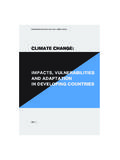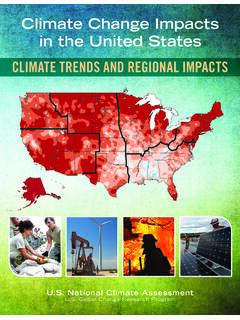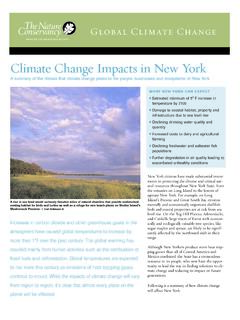Transcription of Expected climate change impacts on soil
1 SPECIAL SECTION. CONSERVATION IMPLICATIONS OF climate change . precipitation may also lead to an increase in Expected climate change impacts on soil biomass production. Higher temperatures may translate to higher evaporation rates, erosion rates: A review while more rainfall would tend to lead to higher soil moisture levels. MA Nearing, Pruski, and O'Neal Temperature changes also afreet biomass production levels and rates in complex ways. ABSTRACT: Global warming is Expected to lead to a morevigorous hydrological cycle, including Corn biomass production may increase with more total rainfall and more frequent high intensity rainfall events. Rainfall amounts and increasing temperature, particularly if the intensities increased on average in the United States duringthe 20th century, and according to growing season is extended, but then may climatechange modelsthey are Expected to continue to increase during the 21stcentury.
2 These decrease because oftemperature stresses asthe temperature becomes too high (Rosenzweig rainfall changes, along with expectedchanges in temperature, solar radiation, and atmospheric and Hillel, 1998). Again, biomass changes CO, concentrations, will have significant impacts on soil erosion rates. The processes involved impact soil surface cover, which greatly in the impact of climate change on soil erosion by water are complex, involving changes impacts erosion. Another potential impact of in rainfall amounts and intensities, number of days of precipitation, ratio of rain to snow, climate change isassociated with the changes plant biomass production, plant residue decomposition rates, soil microbial activity, evapo- from snowfall to rainfall. If decreased days of transpiration rates, and shifts in land use necessary to accommodate a new climatic regime. snowfall translates correspondingly to increas This paper reviews several recent studies conducted by the authors that address the potential es in days of rainfall, erosion by storm runoff effects of climate change on soil erosion rates.
3 The results show cause for concern. Rainfall is liable to increase. Even changes in soil erosivity levels may be on the rise across much of the United States. Where rainfall amounts surface conditions, such as surface roughness, increase, erosion and runoffwill increase at an even greater rate: the ratio of erosion increase to sealing, and crusting, may change with shifts annual rainfall increase is on the order of Even in cases where annual rainfall would in climate , hence impactingerosion rates. decrease, system feedbacks related to decreased biomass production could lead to greater A more complex, but perhaps dominant factor in the equation, is the potential for susceptibility of the soil to erode. Results also show howfarmers' response to climate change 5-3. shifts in land use necessary to accommodate a can potentially exacerbate,or ameliorate,the changes in erosion rates Expected . new climatic regime (Williams et al.)
4 , 1996). As farmers adapt cropping systems, the sus wSp Keywords: climate change , runoff, sediment, soil erosion, soil loss ceptibility of the soil to erosive forces will change . Farmer adaptation may range from ^>. The consensus of atmospheric scientists soil erosion rates may be Expected to shifts in planting,cultivation, and harvest dates is that dintate change is occurring, both in change in response to changes in climate for to changes in crop type (Southworth et al., terms of global air temperature and pre a variety of reasons,the most direct of which 2000,2002a, b; Pfeiferand Habeck, 2002). cipitation patterns. For instance, the year is the change in the erosive power of rainfall The purpose of this paper is to present and 1998 was likely the warmest of the last 1000 (Nearing, 2001; Pruski and Nearing, 2002a). interpret the principal results of four recent years in the Northern Hemisphere (IPCC, A second dominant pathway of influence by studies conducted by the authors in order to 2001), and the year 2001 was second warmest climate change on erosion rates is through show the potential impact of climate change on record (NCDC, 2002).
5 Globally, 9 of the changes in plant biomass. The mechanisms on soil erosion rates, which in turn hassignif 10 warmest years since 1860 have occurred by which climate changesaffectbiomass,and icant implications for conservation planning. since 1990 (WMO, 2001). Warmer atmos by which biomass changes impact runoff and As a whole, these studies provide a good pheric temperatures associated with green erosion, are complex (Pruski and Nearing, overview of both the mechanisms whereby house warming are Expected to lead to a 2002b) For example, anthropogenic increases climate change is Expected to affect soil ero- more vigorous hydrological cycle, including in atmospheric carbon dioxide concentra more extreme rainfall events (IPCC, 1995). tions cause increases in plant production rates Mirk A. Nurfng Is a soil scientist with the Karl and Knight (1998) reported that from and changes in plant transpiration rates Department of Agriculture-Agricultural Research 1910 to 1996 total precipitation over the con (Rosenzweig and Hillel, 1998), which trans Service, Southwest Watershed Research Center in tiguous increased, and that 53% of the late to an increase in soil surface canopy cover Tucson, Arizona.
6 PrutM is a professor in the increasecame from the upper 10% ofprecip and, more importandy, biolo-gical ground Department of Agricultural Engineering at the Fed itation events (the most intense precipitation). cover. On the other hand, increases in soil eral University of Vicosa in Vicosa, Minas Gerais. Brazil. Monte R. O'Neal is a postdoctoral re The percent of precipitation coming from and air temperature and moisture will likely searcher with the Department of Agriculture- days of precipitation in excess of 50 mm has cause faster rates of residue decomposition Agricultural Research Service, National soil Erosion alsoincreased significantly. due to an increasein microbial activity. More Research Laboratory in West Lafayette, Indiana. JIF20M VOLUME 59 NUMBER 1 A3. sion rates and the magnitudes of change that since been found to be a robust parameter in R-fector = + *. we might expect from climate change .
7 We many parts of the world (Larionov, 1993; (r> = ) [5]. will discuss first the effects and mechanisms Schwertmann et al., 1990;Yun et al., 2002). whereby precipitation change itselfinfluences Rainfall erosivity is correlated to the product where: the R-factor is in units of (MJ mm erosion response, and then look at some case of total rainstorm energy and maximum 30 ha'1 year1). (Note that Equation 13 in the studies using output data from Global minute rainfall intensity during a storm paperofRenard and Freimund(1994), which Circulation Models to assess more complicated (Wischmeier and Smith, 1978). The rela corresponds to Equation 4 in this paper, interactions involving precipitation, biomass tionship first derived by Wischmeier and contained a misprint.) Equations 2 and 4 pro production, and other system factors. We Smith is still used today in the Revised vided a better fit on the lower end ofthe data will then overview a case study of potential Universal soil Loss Equation (Renard et al.)
8 , range, and Equations 3 and 5 fit better on the impacts of farmers' response to climate 1997), which is the current technology upper end; therefore Renard and Freimund change forthe Midwestern United States. applied in the United States for conservation (1994) recommended using Equation2 when In most of the studies discussed in this planning and compliance. Studies using a P was less than 850 mm and Equation 3. paper, the Water Erosion Prediction Project physically-based, continuous simulation when P was greater than 850 mm. Likewise, (WEPP) model was utilized (Flanagan and model of erosion have also substantiated the they recommended using Equation 4 when Nearing, 1995; Nearing et al., 1989). The geographic trends of published R-factors for F was lessthan 55 mm and Equation 5 when WEPP model accounts for most of the many parts of the United States, including F was greater than 55 mm. processes and interactions whereby climate western states (Baffaut et al.
9 ,1996). Using these relationships, precipitation out change impacts runoff and erosion. In the Estimations of future climate change pro put from GCMs canbe analyzed for trends in WEPP model, plant biomass production is vided by Global Circulation Models (GCMs) R-factor changes. Nearing (2001) used out influenced by changes in temperature andsoil do not provide the type of detailed storm put from two coupled Atmosphere-Ocean it moisture, and the model was modified to information needed to direcdy calculate pre Global climate Models,one developed by the a.. includethe effects of changes in atmospheric dicted R-factor changes. Hence, statistical Meteorological Office's Hadley Centre carbon dioxide concentrations on biomass relationships between monthly and annual (Gordon et al., 2000; Pope et al., 2000;Wood production. Residue decomposition rates in precipitation and the R-factor must be used et al.
10 , 1999) and the other from the Canadian * ! the model are sensitive to soil moisture and to analyze the GCM output relative to ero Centre for climate Modeling and Analysis <* s temperature. soil moisture is sensitive to sivity changes (Nearing, 2001). (Boer et al., 2000; Reader and Boer, 1998;. rainfall inputs and evapo-transpiration rates, Renard and Freimund (1994) evaluated McFarlane et al., 1992). ? . which are sensitive to air temperature. erosivity at 155 locations within the conti Changes in rainfall erosivity for the two Id Infiltration rates are impacted by residue nental United States, and developed statistical models were computed for two time inter cover and soil consolidation. Canopy and relationships between the R-factor and both vals. In the first case, erosivity values from ground cover are modeled as dynamic vari total annual precipitation at the location and 2040 to 2059 were compared to those from ^3.









